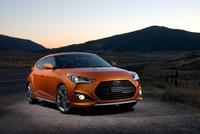2013 Hyundai Veloster Turbo Ride and Review By Thom Cannell
By Thom Cannell
Michigan Bureau
The Auto Channel
Did you wait?
When Hyundai revealed the intriguing new Veloster at the 2011 Detroit Auto Show did you rush out and buy one? Or did you wait for what you knew, knew, had to be tucked away in the product planning office, a turbocharged version of Veloster.
 |
 |
There’s only a few clues to the turbo lurking beneath the menacing exterior, those LED headlamp accents, LED tail lights and turn signal markers, unique body kit with turbo badging and 18” chrome accented alloy wheels, and a superbly executed black rear valance with twin center-mounted exhaust pipes. The hood retains signature indentations and the chunky wheel arches are linked by a crisp beltline that wraps from front through the back to the other side.
 |
 |
Hyundai designers equate piano black accents with luxury, as do Mercedes and BMW, so it’s got ‘em. Fortunately there was no glare from the shiny bits around the HVAC controls, which were joyously simple to use. We also liked the seats for their simple rake/height/fore-aft adjustments. They’re cup-like and fit large and small drivers with comfort while offering enough squish to make aggressive driving less of a butt kick.
Veloster Turbo prices are $21,950 (plus $775 destination) for six-speed manual cars, the automatic adds $1000 or $22,950 plus shipping. When doing comparisons, factor in the standard goodies when pricing competitors like MINI Cooper S or Clubman S, Scion tC, Honda CR-Z, Fiat 500 Abarth, VW Beetle Turbo, VW GTI, or Civic SI. None of those brands offer matte paint; Hyundai is the first volume brand to offer that option.
 |
 |
Hyundai’s twin-scroll turbocharger seems to eliminate any lag from the additional air mass being stuffed into its four cylinders at a maximum rate of 18 psi. Yes, there is an intercooler to take the heat off the charge air. Also, the quick response is due to the turbo’s very close coupling to the exhaust and the twin-scroll turbine housing is made of stainless steel for heat rejection. In an odd way the turbo design makes the big tachometer unnecessary, the engine just pulls hard from 1,600 RPM up to above 6,000 and you never give it a glance. The speedometer, now that’s important! We do think the FWD Veloster’s manual shift mechanism could use a bit more definition, hopefully equalling the RWD Genesis Coupe. It’s got similarly short throws but occasionally seemed a bit muddled (other writers disagreed). The automatic felt flawless and we actually preferred using the paddle shifters to changing gears at the floor mounted shifter, which was perpetually in Sport mode.
The chassis is similar to standard Veloster, constructed mostly of High Strength Steel (according to Hyundai 65% is HSS). The toughest steels surround the passenger cabin like a Sprint Cup roll cage. Compared to V 1.0 the Turbo’s MacPherson front struts and twin-tube dampers have heftier calibrations and it’s 24 mm stabilizer bar is larger. It also shares a V torsion beam rear axle, but has an integrated 23 mm stabilizer bar and uprated monotube dampers. In development engineers discovered that relocating steering knuckles improved steering and handling, requiring relocation of the front brake calipers. They now lead the center line, more 11 o’clock than 3. Expect to see these changes in other Hyundai vehicles.
Hyundai dropped a couple of parking lot events to show us Veloster’s tight 34.12’ turning circle, responsive electronic power steering, brake performance, and chassis balance. It’s got all that, and allowing 30+ auto writers to beat on the cars for hours proved the Turbo has the cojones of a much larger motor, smoking tires in first and second all day—that from a 1.6-Liter motor adjusted to deliver an EPA highway rating of 38 MPG.
Part of the test was full-stop braking from 60 mph, which it did without brake fade throughout the day. That’s due to 11.8” ventilated front and 10.3” solid rear disc brakes. With summer tires and suspension tuning from Eibach and Bilstein you might impress at an autocross or track day. Later, with cruise engaged we could relax and experience the chassis’ solidity and robustness. We noted an open exterior view despite a small rear window and protruding spoiler—as long as you’d properly adjusted both side mirrors. Then even the bumpers and tires of trailing vehicle were in view. We also deeply appreciated steering wheel mounted audio and cruise controls ‘cause the chassis and engine wanted to roll swiftly past the posted limit, a really bad idea in Cali where speeding tickets swiftly shred $600. Do not ask.



